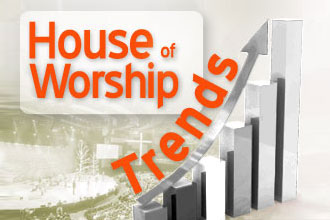Cost Depreciation and the Amortization of Church AVL Technology
 How do you make that large technology investment look approachable? Sell the cost-per-service value. To help churches invest wisely in their Audio, Video and Lighting (AVL) technologies, start with defining value before price is discussed. The price should be what something is after the church buyers have determined the value they can expect to meet their short-term and long-term needs. The house of worship needs to understand cost depreciation and the amortization of church AVL technology.
How do you make that large technology investment look approachable? Sell the cost-per-service value. To help churches invest wisely in their Audio, Video and Lighting (AVL) technologies, start with defining value before price is discussed. The price should be what something is after the church buyers have determined the value they can expect to meet their short-term and long-term needs. The house of worship needs to understand cost depreciation and the amortization of church AVL technology.
Thinking long-term about technology is not something most church leaders have ever considered; they have a pain point, so they buy or lease technology to remedy the pain. This piecemeal approach is actually visible to the naked eye when looking at the front of house booth or video production room at a large percentage of churches, with a mashup of products and brands smattered in equipment racks and on shelves. Though pain points tend to crop up, the systems integrator has the ultimate role to play in building up the relational trust equity to help churches think through their purchases not in terms of cost, but in terms of cost-of-ownership.
 Depreciate Those Assets
Depreciate Those Assets
Depreciation indicates how much of an asset’s value has been used up over time. For example, if a church buys a piece of equipment for $50,000, it can either write the entire cost of the asset off in year one, or it can write the value of the asset off over the life of the asset, which may be 10 years for certain technologies. In business, many owners prefer to expense only a portion of the cost, which artificially boosts net income/revenue, which is not too different from how church accounts operate. In addition, if the equipment can be resold for $10,000, it has a ‘salvage value’ of $10,000. Using these variables, we calculate the depreciation expense as the difference between the cost of the asset and the resale value, divided by the useful life of the asset. The calculation in this example is: ($50,000 – $10,000) / 10, which is $4,000.
This means the church’s accountant does not have to write off the entire $50,000, even though it paid out that amount in cash. Instead, the church only has to expense $4,000 against net revenues. The church then expenses another $4,000 next year, and another $4,000 the year after that, and so on, until the value of the equipment is completely written off in year 10.
Though I’m not a tax expert, I know that contrary to popular belief, churches do pay taxes on certain things like UBIT (unrelated business income tax). They do have to recognize depreciation in their financial statements during filing and do benefit from depreciating assets, just as for-profit businesses do.
Amortize to Prioritize Purchase Decisions
In the finance world, depreciation is applied to tangible assets, whereas intangibles are amortized over time. The principle, however, is that the true cost of technology is a combination of factors, including the purchase price, the expected lifespan of the equipment, the ongoing maintenance cost and the amortization/depreciation schedule. The value of an AVL system is not calculated at the end of a summarized equipment list. No, the net effect is greater than the sum of the parts. So while the depreciation is based on a write-off of the cash investment, helping the church buyer better understand the cost of ownership when it is amortized against usage is a helpful construct for positioning the value of certain technologies against the desires and expectations of the church buyer for the usefulness of the technology as it pertains to how well the technology will meet their short and long-term needs.
A simple example is this: A $50,000 product that can fit a church environment for five years, with five services/events per week would, amortized, cost about $40 per service/event. Framed in a value proposition, this represents the cost a church would gladly spend each week to have its services operate smoothly.
Help the church understand the usable lifespan of your technology so that they can amortize the initial cost out over the lifespan of that product, in not only years but also in the number of services it will likely handle before it’s time to upgrade it. Considering the huge number of churches with multiple services (and even multiple venues and campuses), it’s not unreasonable for a church to have more than 250 services/special events in its venues per year. The value of repurposed equipment can also be a factor in helping to establish a realistic amortization schedule for the life of a product when it is used in primary, secondary and tertiary venues over the years.
Does Your Value Proposition Include Cost of Ownership?
If the value proposition is not a part of the sales process, the price will invariably become the sticking point. When you speak primarily to the price, you’re only talking about the short-term. But when you speak to the value proposition, you’re addressing the long run and helping the church to determine their investment threshold and commitment to leveraging technology. With a value proposition and estimated depreciation schedule over a five to 10 year period, the church can better understand the holistic value of their investment. Further, the amortization discussion flips the convention of a high up-front price for a single purpose to a multiple-purposed viewpoint of cost-per-service.
The quick, easy thing to do is send a templated proposal that includes a generalized equipment list and a pseudo-line item list of equipment. The church buyer can’t see the value — nor how to think about cost-per-service — against a litany of prices and model numbers. Instead, present the value: what the church’s expected cost-per-service/per venue could be based on meeting its short and longer term needs.
Have you ever priced a church AVL upgrade or new system with a cost-per-service value? Share your opinions and experiences in the comments below.





